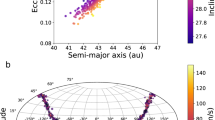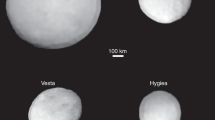Abstract
All asteroids are currently classified as either family, originating from the disruption of known bodies1, or non-family. An outstanding question is the origin of these non-family asteroids. Were they formed individually, or as members of known families but with chaotically evolving orbits, or are they members of old ghost families, that is, asteroids with a common parent body but with orbits that no longer cluster in orbital element space? Here, we show that the sizes of the non-family asteroids in the inner belt are correlated with their orbital eccentricities and anticorrelated with their inclinations, suggesting that both non-family and family asteroids originate from a small number of large primordial planetesimals. We estimate that ~85% of the asteroids in the inner main belt originate from the Flora, Vesta, Nysa, Polana and Eulalia families, with the remaining ~15% originating from either the same families or, more likely, a few ghost families. These new results imply that we must seek explanations for the differing characteristics of the various meteorite groups in the evolutionary histories of a few, large, precursor bodies2. Our findings also support the model that asteroids formed big through the gravitational collapse of material in a protoplanetary disk3.
This is a preview of subscription content, access via your institution
Access options
Access Nature and 54 other Nature Portfolio journals
Get Nature+, our best-value online-access subscription
$29.99 / 30 days
cancel any time
Subscribe to this journal
Receive 12 digital issues and online access to articles
$119.00 per year
only $9.92 per issue
Buy this article
- Purchase on Springer Link
- Instant access to full article PDF
Prices may be subject to local taxes which are calculated during checkout




Similar content being viewed by others
References
Hirayama, K. Groups of asteroids probably of common origin. Astron. J. 31, 185–188 (1918).
Burbine, T. H., McCoy, T. J., Meibom, A., Gladman, B. & Keil, K. in Asteroids III (eds Bottke, W. F. Jr et al.) 653–667 (Univ. Arizona Press, Tucson, 2002).
Johansen, A. et al. Rapid planetesimal formation in turbulent circumstellar disks. Nature 448, 1022–1025 (2007).
Knežević, Z. & Milani, A. Synthetic proper elements for outer main belt asteroids. Celest. Mech. Dyn. Astr. 78, 17–46 (2000).
Nesvorný, D. Nesvorný HCM Asteroid Families V3.0. EAR-A-VARGBDET-5-NESVORNYFAM-V3.0 (NASA Planetary Data System, 2015).
Nesvorný, D., Broz, M. & Carrruba, V. in Asteroids IV (eds Michel, P. et al.) 297–321 (Univ. Arizona Press, Tucson, 2015).
Zappala, V., Cellino, A., Farinella, P. & Knežević, Z. Asteroid families. I. Identification by hierarchical clustering and reliability assessment. Astron. J. 100, 2030–2046 (1990).
Parker, A. et al. The size distributions of asteroid families in the SDSS Moving Object Catalog 4. Icarus 198, 138–155 (2008).
Milani, A. et al. Asteroid families classification: Exploiting very large datasets. Icarus 239, 46–73 (2014).
Bottke, W. F., Vokrouhlický, D., Rubincam, D. P. & Broz, M. in Asteroids III (eds Bottke, W. F. Jr et al.) 395–408 (Univ. Arizona Press, Tucson, 2002).
Spoto, F., Milani, A. & Knežević, Z. Asteroid family ages. Icarus 257, 275–289 (2015).
Dohnanyi, J. S. Collisional model of asteroids and their debris. J. Geophys. R. 74, 2531–2554 (1969).
Durda, D. D. & Dermott, S. F. The collisional evolution of the asteroid belt and its contribution to the zodiacal cloud. Icarus 130, 140–164 (1997).
Vokrouhlický, D. & Farinella, P. Efficient delivery of meteorites to the Earth from a wide range of asteroid parent bodies. Nature 407, 606–608 (2000).
Bottke, W. F., Rubincam, D. P. & Burns, J. A. Dynamical evolution of main belt meteoroids: numerical simulations incorporating planetary perturbations and Yarkovsky thermal forces. Icarus 145, 301–331 (2000).
Jacobson, S. A., Marzari, F., Rossi, A., Scheeres, D. J. & Davis, D. R. Effect of rotational disruption on the size-frequency distribution of the main belt asteroid population. Mon. Not. R. Astron. Soc. 439, L95–L99 (2014).
Morbidelli, A. & Nesvorný, D. Numerous weak resonances drive asteroids toward terrestrial planet’s orbits. Icarus 139, 295–308 (1999).
Minton, D. A. & Malhotra, R. Dynamical erosion of the asteroid belt and implications for large impacts in the inner Solar System. Icarus 207, 744–757 (2010).
Delbo', M., Walsh, K., Avdellidou, C., Morbidelli, M. Identification of a primordial asteroid family constrains the original planetesimal population. Science 357, 1026–1029 (2017).
Milani, A. & Nobili, A. Integration error over a very long time span. Celest. Mech. Dyn. Astr. 43, 1–34 (1988).
The OrbFit Software Package (The OrbFit Consortium); http://adams.dm.unipi.it/orbfit/
Carruba, V.,Burns, J. A., Bottke, W. & Nesvorný, D. Orbital evolution of the Gefion and Adeona asteroid families: Close encounters with massive asteroids and the Yarkovsky effect. Icarus 162, 308–327 (2003).
Murray, C. D. & Dermott, S. F. Solar System Dynamics (Cambridge Univ. Press, Cambridge, 1999).
Fisher, R. A. Statistical Methods for Research Workers 14th edn (Hafner, Darien, 1970).
Masiero, J. R. et al. Asteroid family identification using the Hierarchical Clustering Method and WISE/NEOWISE physical properties. Astrophys. J. 770, 7–29 (2013).
Acknowledgements
A.A.C. thanks Z. Knežević for his advice on using ORBIT9 and on generating proper elements, and acknowledges the SFI/HEA Irish Centre for High-End Computing (ICHEC) for the provision of computational facilities and support. Astronomical research at the Armagh Observatory and Planetarium is funded by the Northern Ireland Department of Communities (DfC).
Author information
Authors and Affiliations
Contributions
S.F.D. initiated and directed the research and wrote the paper. A.A.C. performed the numerical investigations of chaotic orbital evolution and wrote the corresponding part of the Methods. D.L., T.J.J.K. and J.M.R. contributed to the data analysis.
Corresponding author
Ethics declarations
Competing interests
The authors declare no competing interests.
Additional information
Publisher’s note: Springer Nature remains neutral with regard to jurisdictional claims in published maps and institutional affiliations.
Supplementary information
Supplementary Information
Supplementary Figures 1–5, Supplementary Tables 1–2
Rights and permissions
About this article
Cite this article
Dermott, S.F., Christou, A.A., Li, D. et al. The common origin of family and non-family asteroids. Nat Astron 2, 549–554 (2018). https://doi.org/10.1038/s41550-018-0482-4
Received:
Accepted:
Published:
Issue Date:
DOI: https://doi.org/10.1038/s41550-018-0482-4
This article is cited by
-
Shapes, structures, and evolution of small bodies
Astrodynamics (2021)
-
Tracing escapees from collisional families
Nature Astronomy (2018)



